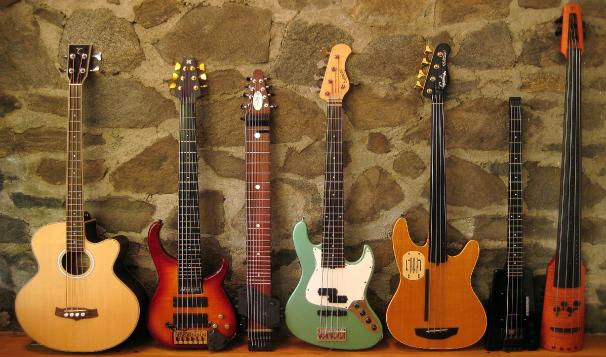
pictured left to right: Tanglewood acoustic bass; Modulus Quantum 6 w/Axon MIDI; Chapman Stick SB8 w/Roland MIDI; Sadowsky vintage PJ5; Godin A4; Steinberger XL; NS Design CR double bass
Dave endorses NS Design instruments.
instruments
Sadowsky vintage PJ5
NS Design CR4 bass
Sterling Music Man Ray35CA w/Seymour Duncan 3-band preamp
Ibanez Mikro 5 string (baritone piccolo tuning)
Modulus quantum 6 w/EMG 45JCSX pickups and hipshot bridge
Fender fretless J-bass (MIJ) w/DiMarzio "Sixties J" pickups and Audere preamp
Tanglewood acoustic bass guitar w/Fishman electronics
Steinberger XL bass (used for various non-standard tunings)
Godin A4 acoustic/electric fretless bass
Chapman Stick SB8 w/Roland MIDI pickup
Chapman Stick (white polycarbonate)
Fender '70 P-bass
Fender '78 musicmaster bass
Martin '25 A style mandolin
Ibanez Artist guitar
Partscaster Strat (Stew Mac/Guitar Fetish/Seymour Duncan/Wilkinson/Sperzel/Roland)
Peavey Cyberbass MIDI
Guild/Ashbory bass
amps/cabs
Markbass Little Mark 58R amplifier
Markbass MR58R 102 cab
GK 1001RB amplifier
GK NEO 210 cabs
GK MB200 amplifier
Eden WT-800 amplifier
Eden 210XLT cab
Rocktron Voodu Valve guitar preamp
Rocktron 112 Velocity guitar cabs
Seymour Duncan powerstage 100 stereo
TC BAM 200 amplifier
TC 208 cab
SWR SM400
SWR 410 Goliath cab
Roland bass cube 60
Fender Pro Reverb
EFX/signal processing
Boss GT-6B bass multi-effects pedal
Line 6 M9 effects modeler
Eventide H9 max
Rocktron All Access
Tech21 VTbass DI
Tech21 Q strip
DSM/Humbolt bass simplifier
BOSS OC-5 Octave
Digitech Jamman
Radial Engineering big shot A/B
Digitech Whammy pedal
CFG UHF wireless
BOSS TU-12 tuner
recording tools
UA LA-610 mkll
Avalon U5
Avalon 737
Radial JDI passive DI (2)
